#series-parallel-circuit-difference
Explore tagged Tumblr posts
Text
OFF THE GRID [TEASER]

pairing: f1driver!scoups x ex!femreader
genre: angst, romance, exes to lovers au, childhood bestfriends / neighbours au
description: Part of the Beyond The Grid series. Four-time world champion Choi Seungcheol has spent years at the top with Ferrari, but as the 2025 season drags on, he can’t shake the feeling that he’s not quite where he used to be. The competition is catching up, his team isn't what it used to be, and for the first time, he’s starting to wonder if he’s past his prime. By the time the season winds down, he finds himself back in his hometown, which isn't quite the same either. But the hardest race was never on track, and sooner or later, he’ll have to figure out what comes next.
warnings: strong language, stressful situations, descriptions of car crashes and physical exhaustion, f1 heavy, miscommunication
teaser w/c: 1.3k fic w/c: 46.5k . Part 1
glossary
a/n: While it is not required to read Lights Out to understand what's going on here, the first half of this fic runs parallel to it. I personally had fun writing the parallels, oh you know, the downfall of one, rise of another. If you've read lights out though, you probably know how this weekend ends, but shush! LMAO. This one's run longer than I expected it to, so it'll be divided into three parts. Again, the glossary helps, so do read it! you can sign up for the taglist here !

ITALY, AUTODROMO NAZIONALE MONZA
Saturday, Qualifying
The roar of the Tifosi is deafening, even from inside the garage.
Seungcheol sits in his cockpit, helmet still on, hands resting lightly on the wheel as the mechanics swarm around his car, making final adjustments. The session clock is still running, but for now, he’s stationary—P3 on the leaderboard, a tenth ahead of Jaehyun.
Outside, Monza is alive.
The Tifosi are everywhere, packed into every inch of the grandstands, a sea of red that stretches as far as the eye can see. Flags whip through the air, massive banners draped across the stands, their messages bold and impossible to miss. Monza is one of the circuits where the grandstands are sold out even during qualifying. There’s something different about this place. Something that doesn’t exist at any other circuit, something even the best drivers struggle to explain. It’s not just the speed, the history, the track itself. It’s this. The weight of expectation. The way Ferrari doesn’t just belong to the team—it belongs to the people. To the thousands in the stands who live for this weekend.
Usually, Monza is Seungcheol’s favourite track. He’s set impressive records here before and the energy of the crowd is always motivating.
Even through the layers of his helmet, his balaclava, and the deafening sounds of the other cars on the track, he hears them chant his name.
At least they haven’t given up on me.
His fingers tighten slightly around the wheel.
He sits in P3 for now. Ahead of Jaehyun, but still behind a Red Bull. A Red Bull on pole.
At Ferrari’s home race.
It’s an insult to their team, a disgrace on their part.
His gaze flickers across the garage, past the blur of engineers watching the monitors, past the mechanics murmuring updates to one another. No one looks at him. Not directly. Not long enough for it to mean anything.
But they’re waiting.
They won’t say it, won’t dare to speak it aloud but he knows what they need from him.
They need him to take back Monza.
They need him to put Ferrari back where it belongs.
Like always. Funny that they need me, now that their new star driver can’t manage to fucking qualify above P5 when it actually matters.
His race engineer's voice cuts through his earpiece, slightly more alert now.
“Track is clear. Sending you out now.”
Seungcheol scoffs, a humorless laugh against the inside of his helmet.
Right. Of course they are.
He presses the clutch paddle, lets the engine roar back to life, and rolls out onto the pit lane.
The television flickers, the glow of the screen casting soft light across the dimly lit living room. You keep the volume as low as possible. Your parents are sleeping, and you wouldn’t want to wake them up because of the commentary at this ungodly hour.
You hadn’t planned on watching qualifying. It had been a long day and the last thing you needed was to be up at one in the morning, wet hair dripping onto your t-shirt after a bath, on the edge of your seat as you watched your ex-boyfriend qualify for his team’s home race.
You should be asleep, but instead, you sit curled into the corner of your couch, staring at the leaderboard on the screen.
P3 – Choi Seungcheol.
The commentators have been talking about him all session. About how this weekend is crucial, about how Ferrari needs a strong result at their home race. About how Jaehyun is only P5 and how Seungcheol is the only Ferrari in a position to fight for pole.
The pressure is unbearable even from here, thousands of miles away. You can only imagine what it must feel like there, in the cockpit, in that worrying little head of Seungcheol’s.
The camera cuts to the Ferrari garage, to Seungcheol sitting in his car, helmet on, hands loose on the steering wheel as he waits.
Your stomach twists as his engineer’s voice crackles through the radio.
"Track is clear. Sending you out now."
Seungcheol doesn’t respond. Just shifts into gear, rolling out of the garage onto the pit lane.
The commentators barely take a breath before launching into his out-lap analysis.
"This is it, folks. One final shot for Ferrari’s Choi Seungcheol. He’s currently sitting in P3, but can he challenge for pole?"
"He’s had a tough session so far, struggling with the car’s balance, but he’s pulled off magic laps before. Let’s see what he can do."
You exhale slowly, pressing your knuckles against your lips as the camera follows him through the out-lap. He’s weaving aggressively, warming up his tires, testing every movement.
And then, finally—
"Choi Seungcheol begins his final lap."
The screen shows his car flying into a long, sweeping curve, and something tugs at your memory.
"It’s trickier than it looks," Seungcheol had once told you. It was late, the two of you sitting in the dim glow of his kitchen after Monza in 2023. "It’s easy to take it flat-out, but if you misjudge the line by even half a meter, you’re screwed on the exit."
Your breath catches slightly as you watch him now, the Ferrari holding steady, perfectly placed, just like he described.
The timing screen flashes, indicating a purple sector.
The commentators react instantly.
"He’s improving! Seungcheol is on a great lap. Can he challenge for pole?"
Your fingers tighten around the edge of the blanket draped over your legs.
The car flies through the next sector, fast and on the edge. There’s no hesitation, no second-guessing. It’s pure instinct, the kind that only comes after years of knowing exactly where the limit is.
Purple again.
"He's still gaining! This could be huge for Ferrari!"
You don’t even realize you’re holding your breath.
The final corner looms. The moment of truth.
"It’s deceptive," he'd said, "the Parabolica. The biggest mistake is to brake early. If you do, you lose all your momentum. You have to trust the car. Trust yourself."
His Ferrari dives in so late you think for a second that he’s overdone it. But who are you kidding? It's Seungcheol. Seungcheol who would never settle for anything less than a front row at Monza. He knows what he's doing.
As he crosses the finish line, the leaderboard updates.
P2.
The commentators erupt—a front row start for Ferrari. The camera cuts to the grandstands, where thousands of fans in red are screaming his name.
You exhale.
Not pole.
But at least he’s ahead of Jaehyun.
The screen flickers back to the garage. Seungcheol removes his helmet slowly, setting it down beside him. He doesn’t look at anyone, doesn’t react to the pats on his back. His expression is unreadable.
Seungcheol is disappointed. Yes, he's out-qualified Jaehyun. But a Red Bull still sits on pole. Another at P3. His teammate's stuck at P5.
He mentally scoffs, A championship contender, that boy.
It's been a hard weekend for Ferrari this year. The Red Bulls have been fast all weekend. All season, but this weekend matters the most and Seungcheol has a chance. To prove to the team, to prove to himself and to win for the fans.
He watches as Jaehyun gets out of his cockpit, looking thoroughly frustrated for once.
Good, Seungcheol thinks. He's not going to be able to fight for the championship always, but if Ferrari has any chance of challenging for the constructors then Jaehyun needs to start doing better. Needs to start being harder on himself.
As his PR manager approaches him, Seungcheol thinks about what this year's driver’s championship winner would mean. If it’s going to be Haechan, which seems to be the most probable case, then that would mean the downfall of Ferrari again. If Jaehyun won against the odds, it would mean that Seungcheol lost to a teammate for the first time in his career.
Ferrari is going to start asking him to play the team game soon. He's not going to have the choice to deny that. He just hopes it doesn't start tomorrow.
He needs that win.

#seungcheol x reader#scoups x reader#svthub#kstrucknet#kflixnet#choi seungcheol x reader#choi seungcheol#svt scoups#seungcheol angst#seungcheol fluff#svt angst#seventeen angst#seventeen fluff#seventeen x reader#seventeen imagines#scoups imagines#scoups oneshot#seungcheol oneshot#seventeen seungcheol#tracks by calli 💿
463 notes
·
View notes
Text
I attended a series of lectures on neuroscience these last few days (well, they were a super basic cliffnotes-esque version of the topic cause medicine/STEM is not my field of work, so apologies for any innacuracies ahead), and when the lecturer brought up the importance of the frontal lobe, she casually alluded to what happened to Phineas P. Gage and-

wbk but also non-accidental split imagery one more time ^
She also briefly touched upon the 'cuts' of the brain (left and right hemispheres, lobes —and primary functions of each—, gray and white matter) and neural processes like synapsis —communication between neurons by chemical and electrical reactions—, but one of the things that stood out to me the most was the creation and reconfiguration/transformation/plasticity of neural circuits.
A neural circuit is a population of neurons interconnected by synapses to carry out a specific function —i.e. processing specific information and sending signals to other parts of the brain and body — when activated.
definition just for context; the point of bringing this up being what these circuits look like:

^^^this is just a guide alluding to the differences in morphology neurons can have, but they kinda giving-

and-

literally when the lecturer first showed what these cells look like I was like "neat, the tree of life. kinda, sorta. out to deliver trauma to the rest of the nervous system :))"
and (to the right, for comparison: what neuron synapses look like)


and of course, not totally accurate comparison ahead, but I couldn't resist the slight visual graphy coinkidink with the letter-assigned grid:

Additionally, zooming out, multiple neural circuits can interconnect with one another to form large scale brain networks, and the one that stood out to me was the default mode network (DMN):
also known as the medial frontoparietal network, it's a large-scale brain network [...] best known for being active when a person is not focused on the outside world and the brain is at wakeful rest, such as during daydreaming and mind-wandering.
Other times that the DMN is active include when the individual is thinking about others, thinking about themselves, remembering the past, and planning for the future. The DMN creates a coherent "internal narrative" control to the construction of a sense of self.
^ smart people, pls do with this info what you must.
the point I think I was trying to make: what if the blue UD we know has blurred the lines between being a representation of will's subconscious mindscape and also a visual abstraction of the biological/neurological state of his brain —as the two, like irl, are so intrinsically connected?
which, fortunately, means hope for will and the UD too (wbk), because by this line of thought/theory of sorts, the capacity neural circuits have to rearrange themselves, even after years and so much pain, can transform the blue UD, will's mind, as we've come to know it (the plasticity I was reffering to at the beginning of the post). However, it's important to note that to learn something new, you have to unlearn other stuff to make room for it.
I'm far from the first to talk about this topic, so check out the following posts! This one by @erikiara80, along the lines of her loop theory, dives into the implications of will's possible injury or death caused by having been hit on the head, particularly the zone closest to the frontal lobe, by a blunt object.
@conflictofthemind also has a great post about the treeflayer (shoutout and tysm to @threemanoperation for telling me about it and for prompting me to post this) with more tree imagery that evokes similar shapes to those of neurons (and it also links to Alice in Wonderland and Peter Pan/Neverland parallels).
edit: everyone, please take a look at the additions other users have written on their reblogs! you won't want to miss them!
#stranger things#will byers#something something the ud trees and vines are not good or evil they just are#same with our fucked up brains#stranger things theory#tags for engagement#byler#< target audience#stranger things 5#st5 speculation#st5 leaks#artistic licence: neuroscience#med students i'm sorry
173 notes
·
View notes
Text
How do Pikachu produce electricity?

(This is a photo of my Pikachu, Eggnog, blending in with a bunch of plushies on my bed. Isn't she cute?)
Electric types are my specialty, so I thought a great way to start off this blog would be to get into the anatomy of electric organs in pokemon! It differs depending on the species, but its pretty conserved among electric mice.
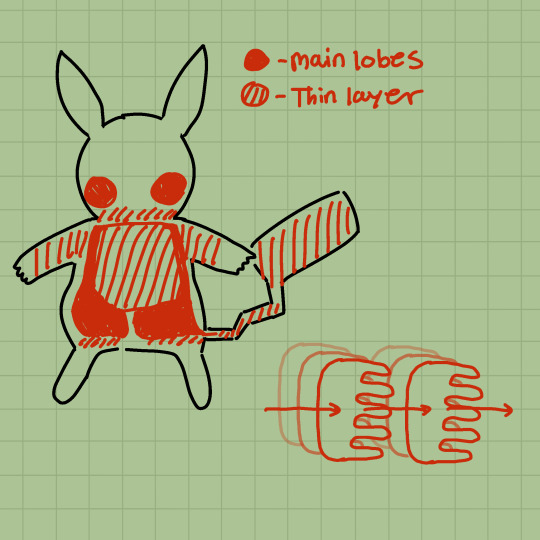
Much of Pikachu's body is made up of two dense electric organs in its body cavity. Most of the mass is in the lower half of the body, separated from the organs by a relatively thick layer of insulating fat. This is why Pikachu are heavier than you might expect for their size! These organs are made of layers of thousands of columns of cells called electrocytes arranged in series, with parallel layers separated by thin insulating tissue to prevent short circuiting. This enables them to efficiently build a high amount of current and voltage very quickly. In the chubbier parts of the arms, tail, and insulated from the organs in the rest of the body cavity are thinner layers of electrocytes to maximize electricity generation.
Interestingly, electrocytes are actually a type of modified muscle cell! Each cell is innervated by a nerve terminal where neurotransmitter release triggers an action potential similar to those in muscle cells and neurons.
The electric organs are beneath the muscle layer and separated by another layer of insulation to prevent seizing during the release of electricity. Insulated channels between the muscle layer allows the produced electricity to move past the muscle and escape through the skin. These channels can be opened and closed to direct electricity to different parts of the body for different moves (think Electro Ball!)
Pikachu fur differs from non-electric type furry pokemon in that it's actually composed of a mixture of several metals (primarily copper and zinc) coated in a thin layer of a protein similar to the chitin found in bug types. In this way, the fur acts more to conduct electricity than to insulate the pokemon against temperature loss. This makes temperature control a challenge for Pikachu, but the thick layers of fat insulation, metabolic heat from electricity production, and social huddling helps keep them warm.
You might've noticed that Pikachu's striking red electric sacs in its cheeks are completely hairless. This helps it directly conduct electricity in smaller amounts, like when communicating. These sacs are also the only electricity-generating organs in its head, and are thoroughly insulated to prevent any misfiring to the brain. This has the side effect of making its cheeks extra stretchy and squishy!
These electric sacs also differ from the main electric organs in that they have specialized battery glands that can store even more electricity. When Pikachu is asleep, they're able to "recharge" these glands similar to the process in rechargeable batteries, except with very minimal efficiency loss over its lifespan.
And there you have it! A basic run down of how Pikachu generates electricity. If you have any questions or comments, please feel free to let me know! And of course, if you have any corrections, please let me know as well! I'm pretty experienced with electric types but I'm also still just a student. :]
72 notes
·
View notes
Text
This Week in BL - The Industry is Having Issues But the Spice Spicy Must Flow
Organized, in each category, with ones I'm enjoying most at the top.
March 2024 Wk 4

Ongoing Series - Thai
Two Worlds (Thurs IQIYI) eps 1-2 of 10 - One of those "he's dead Jim so time travel" thingames starring MaxNat. I'm over this concept but I do enjoy MaxNat. Phupha (Gun) and Khram (Nat) love each other but Phupha is murdered. Then Khram is pulled to a parallel world where, years ago, Khram and Tai (Max) were in love. However, Khram was killed by Tai’s dad. Now Tai finds alter-Khram. But then there is ALSO an alter-Phupha to deal with. (Phupha is played by Gun Thanawat who was Khom, the repressed butler bodyguard from Unforgotten Night. We like this, but we scared of the love triangle aspect.) Did that make sense? Yeah, okay, see what I mean?

Initial thoughts?
The subs are troubling but I’m enjoying this show a lot. It’s nice to see MaxNat get something meaty to sink their teeth into - that’s not just each other. Also it’s so smart of them to give us a fully fleshed out entire episode developing the alter romance rather than just a separation + death. It makes Khram’s grief and motivation that much more believable. Also it’s really nice to see Nat have good chemistry with other actors.
Deep Night (Thurs iQiyi) ep 3 of 8 (10?) - I'm still enjoying it. But Two Worlds is objectively better. So this one has lost ranking. Also, unexpectedly chili (the name of my heavy metal Thai cover band).

Lovey switchy and verse main couple too.
This is all quite pleasing.
The bit where the hosts pretend to be a BL couple actor ship was epic on so many levels.
Also unsettling.


All sex work is performative, and in a way there is something more honest about this depiction, in this setting, than what BL actors are made to do on the promo circuit. Which then begs the question, how different is BL from sex work? That's the unsettling bit, for me anyway. Not to slam on sex work AT ALL, we pro-the-true-pros on this damn blog, but actors have been shaded by association with True Professionals for a very long time and BL has already had one epic shut down in this regard. (See the PerthSaint scandal around Love By Chance, no I will not explain.) Where was I? Oh yes, so anyway, see the Gossip section for the part where they better be paid either way!
Also, since I'm a warped fucker, I found this scene funny.
And then hilarious when all of those BL tropes were just trotted out. Like a greatest hits reel.
Truly beyond meta. (How Absolute BL of them.)
Note he’s even standing in yaoi's patented "hands in pocket with the shoulders back"?

Meanwhile, the gayest bridge in Thailand made its quarterly appearance:

And lip serviced was paid to the most touristy romantic things you can do in Bangkok.
And I mean lip service literally.

To Be Continued (Thai C3 Thailand grey) ep 5 of 8 - I’m still enjoying it but getting more and more nervous. We getting too close to Promise territory for comfort. EXPLAIN Ji’s reticence well and do it now or risk audience mistrust. We have to be given a GOOD reason for Ji's behavior, or he'll be irredeemable.
City of Stars (Fri iQIYI) ep 8 of 12 - NO SINGING. Yes smiley kisses and good communication and a nice healthy relationship. But no singing!

1000 Years Old ep 6 of 12 - Dropping in the ranks. I’m sorry it’s just gotten boring. It has, however, inspired me to invest in my own ridiculous cream fuzzy sweater. Which I plan to wear with leather trousers and huge stumpy boots, like the Kpop queer I truly am. Or do I mean vampire?
Kiseki Chapter 2 (Sun iQIYI) ep 1 of 6 - Seems to be an excuse for a small posse of Thai actors to wander around Tokyo playing tourist and sing in public . Someone stop them?
“Most people think this kind of thing is bad manners .”
Anyway, it’s v boring. I’ll give it one more ep but I suspect I’ll DNF.
Close Friend Season 3: Soju Bomb! (Weds iQIYI) eps 1-2 of 6 - Meh. This is also looking suspiciously DNF-a-licious.

Ongoing Series - Not Thai
Unknown (Taiwan Tues Youku YouTube & Viki) ep 5 of 11 - It's brilliant. I love it. I'm ready to hurt. Let’s do this thing.
Distribution note: This one has been picked up and is also airing on Viki now, so it may lose YT distribution in soem territories. I like Youku's hard subs better than Viki's subs, but that's a matter of preference not information since I don't speak Mandarin.
Love is Better the Second Time Around AKA Koi wo Suru nara Nidome ga Joto (Japan Weds Gaga) ep 3 of 6 - It is good. Every week I like this show a little more. I'm enjoying a reunion romance explored in Japan's quintessentially contemplative yet slightly surreal way. The juxtaposition of the tenderness of the sex scene with this Japanese brand of authenticity was oddly elegant - for lack of a better way of putting it. All in all, this is a good show. Thought provoking. Stylish.
AntiReset (Taiwan Fri Viki/Gaga) ep 9 of 10 - It remains lovely but they sure are reusing a lot of footage. Also, this was a classic penultimate doom episode. I do wonder how they are going to resolve this show ethically.
My Strawberry Film (Japan Thurs Gaga) ep 6 of 8 - It is what it is, and it isn’t my style of show no matter what country of origin. Oddly that's one of the reasons I don't like it. Anyone could have made this, it's not as Japanese as I want it to be, it's just indie film club high school angst. Yawn.

I watched it, finally
The Servant and the Young Master (Vietnam YouTube) 7 eps - I dislike vertical filming, but I kind of enjoyed this show as a BL. I like class conflict romances. For me the rich kid is a bit too dictatorial (edges into bulling), but it’s kinda works. It’s sparse and underdeveloped and a bit plotless, but mildly entertaining. If you're missing Vietnamese BL you might give it a try. 6/10
Began Beginning (Myanmar YouTube) 8eps - A Burmese BL that I had thoughts about but actually ended up recommending. Read the saga here:
It's done, ready to binge, but I suck
What Did You Eat Yesterday Season 2 AKA Kinou Nani Tabeta? Season 2 (Japan Gaga) 10 eps
It's airing but...
Graduation Countdown (Taiwan YouTube) ep 1 of ? - on one hand it's micro-installment vertical, on the other it's adorable and from Taiwan. I blame @heretherebedork entirely for my conundrum. As indeed, I did for My Type back in the day. (That was Nat Chen's first BL, yes of Kiseki: Dear To Me fame.) So I think I will also simply lean on Here to let me know when it's done and binge all at once. It's just too much to ask me to keep up with 2 minute pieces, I don't have that kind of endurance training, not even for BL.
Time the series (Tue Gaga/YT) 10 eps - it's finished now, I dropped it at ep 4. Should I bother?
A Secretly Love (Thai Sat WeTV grey) 10 eps - I watched the first ep but grey is too much work for this inferior of a show. I may pick up and binge if it gets distribution but for now, it gets a DNF from me. KimCop might have held this crap together but Kim without Cop? No thank you.
Lady Boy Friends (Thai WeTV grey) 16 eps - reminds me a bit too much of Diary of Tootsies only high school. Not my thing. DNF unless it turns a corner and is truly amazing for some reason.
Man Suang that MileApo vehicle from last year is coming to Netflix in the USA. I haven't heard much about it and since the KP stans would have lost their tiny minds if it was any good at all, I'm assuming it's not good at all.

Gossip
Thai BL actor Yoon breaks with his former company and talks about some very very VERY shady goings on in the Thai BL industry. Including not being paid.
And whacha know, same thing happening in Korean BL.
Have I mentioned recently how much I hate the film industry?
Next Week Looks Like This:

Starting Soon
3/31 Only Boo! (Thai GMMTV YouTube) 12 eps - New main couple for GMMTV in an idol romance about a boy who dances good and a food stand vendor. Other side of the tracks grumpy/sunshine pair who fall deeply in love but, of course, baby boy idol can't date. Boyband but from GMMTV? Control your singing and I'm game.
4/1 Love is like a Cat (Korea ????) 12 eps - This completed filming Aug 2022(!) which means there have been serious problems with post-production. This is another of Silkwood's Korean+Thai colab projects. Mew Suppasit plays a rookie film star, called the Cat Prince (for his cold arrogance) who goes up against a charismatic puppyish animal daycare director (JM of JUST B). There is also a side romance (love triangle?) with a veterinarian. Geonu of JUST B is also in the cast.
I wonder if this was part of the hold up, with Geonu on Build Up right now, they might have tried to muffle this one. Or maybe it's just that bad...
4/3 We Are (Thai GMMTV YouTube) 12 eps - University ensemble BL featuring PondPhuwin, WinnySatang, AouBoom, MarcPawinPoon - basically the good kind of messy gay friendship group (so more My Engineer and less Only Friends). Looks a bit like the Kiss series but everyone is queer. I'm IN!
Knock-Knock Boys (Thai WeTV?) - 4 college friends conspire to help their friend lose his virginity. Familiar faces like Seng (yes, Billy's previous partner), Best and frest face, news here.
Upcoming BLs for 2024 are listed here. This list is not kept updated, so please leave a comment if you know something new or RP with additions.
NOTE: It looks like one of my personal favorites of last year Unintentional Love Story is getting a spin off!
THIS WEEK’S BEST MOMENTS

Without ghost girl.

With ghost girl.
I think she may be my favorite part of 1000 Years.

CLASSIC tsundere seme description of a sunshine uke. Like classic'est of classic. (Two Worlds)

Is there such a thing as a tired trope in a BL? Since it is a genre that is made up entirely of tropes quilted together? Your philosophical question for today brought to you by Deep Night's kabedon (Japanese trope) + punishment threat (Thai trope).

Love me a lap sit moment. (City of Stars)
(Last week)
Streaming services are listed by how I (usually) watch, which is with a USA based IP, and often offset by a day because time zones are too much work.
The tag BLigade: @doorajar @solitaryandwandering @my-rose-tinted-glasses @babymbbatinygirl @babymbbatinygirl @isisanna-blog @mmastertheone
If ya wanna be tagged each week leave a comment and I will add you to the template. Easy peesy.
#this week in bl#bl updates#The Servant and the Young Master#The Servant and the Young Master reviewed#Vietnamese BL#Two Worlds the series#To Be Continued the series#City of Stars#Unknown the series#Love is Better the Second Time Around#Koi wo Suru nara Nidome ga Joto#AntiReset#1000 Years Old#Deep Night the series#bl series review#upcoming bl#bl news#bl reviews#thai bl#japanese bl#taiwanese bl#koren BL#BL gossip#BL updates#BL starting soon
236 notes
·
View notes
Text
An Overview: Feeder Series
Hello, this post is a response to an ask about feeder series. It will be pretty basic of an overview because there are about a billion feeder series, but if there is any particular series someone wants me to go more intensely in depth on, let me know. Enjoy!
So, as stated in my earlier post about the path to F1 drivers work their way up through feeder series before garnering enough attention to make it into F1. Feeder series are just lower level racing series that are similar to F1, but often gentler. They are also grouped under about three categories.
Formula 4
This category was officially created in 2014 by the FIA in order to create a standard first step for drivers to take into single-seaters. There are regional and national F4 series, and it is not just one series the way F1 is. For example there is the Italian F4 Championship, The F4 British Championship, etc. F1 Academy is also under the F4 category. This category is marked by a much slower car, much less complicated electrical working, and slightly different car structure. Most drivers start out in the more local F4 series, and then move onto the bigger name ones as their careers progress. The F4 category has pretty much stayed the same since it began, but like with F1, new regulations are added every year.

(A modern F4 car. You can see how much more simple and wide it is than an F1 car)
Alumni:
Charles Leclerc
Max Verstappen
Pierre Gasly
Formula 3
The concept of F3 has existed for a very long time. It was created as a national pathway into F1 around the 1950s, but has changed tremendously as the years have gone on. The biggest changes surrounded how the cars are structured and the number of series within F3. For example engine sizes increased between the 1960s and the 1980s, and more national series started getting added to the category during this time as well. It exploded in number in the 90s and 2000s, and now envelops both regional and national series.
As previously stated, there are many different series inside of the modern F3 category, just like in F4, with the FIA Formula 3 Championship being the major one (created in 2019). Interestingly, the FIA F3 Championship series was created after the merging of European Formula 3 Championship and GP3, which had been the two biggest feeder series for years. They merged due to the need for more streamlined paths into F1. Also, the FIA wanted more consistency in racing weekends and better cost control. This merging saw the creation of modern F3 as we know it. The FIA F3 Championship nowadays is a one-make series, which means that equipment is equal between teams.

(A 2025 F3 car, still simple but getting more sleek and technical)
Alumni:
Mick Schumacher
Liam Lawson
Lando Norris
Formula 2
F2 was introduced in the early 50s as the category below F1 (often as a cheaper option). It was called F2 back then, then switched to Formula 3000 until the 80s, then GP2, then F2 again. These switches were mostly due to different organizational or structural changes over the years. For example, they went from F2 to F3000 because they switched engine types and altered everything organizationally to make it a little more cost effective. Another example of reasons why a name changed is that GP2 became F2 in 2017 because they wanted to make Formula 1 and it's feeder series a more connected and recognizable brand.cLike F3 and F4, there are multiple series in the F2 category (one for most major motorsport countries) but the biggest one is the FIA Formula 2 Championship, which is also a one-make series.

(Getting even closer to an F1 car, F2 cars are by far the most similar but not quite as fast or complicated as F1)
Alumni:
George Russell
Lance Stroll
Oscar Piastri
Now, to finish up, you must know that F2,F3, and F4 run parallel weekends to F1, with small differences. They each have select weekends where they run at the same circuit but different times to F1. This is in the hopes of getting more attention on the lower series because people will be there to watch the F1 weekend. Not every weekend is parallel to F1, of course, just the ones that are convenient or doable. For example, F4 series end their season earlier than F1 so they aren't there the latter half of the year. Also, the Italian F3 Series will never run races anywhere but in Italy, so they join F1 when they race in Monza and Emilia Romagna.

(A modern F1 car to compare. Much more visibly complicated and often smaller as well. Built for much faster speed.)
Alright, that is a basic overview on feeder series. I hope I answered all of your questions.
Cheers,
-B
16 notes
·
View notes
Text
Today I am pleased to present my most recent get: A 2023 Toyota GR Corolla, from Hot Wheels' late 2024 Premium series Slide Street 2, a series focused on pro drift vehicles.

To be exact, it's the Toyota GR Corolla driven by Ryan Tuerck in Formula Drift, and I got it because my wife and I recently traded our super-basic 2010 Toyota Aygo for a 2022 Corolla - not a GR, but miles more powerful and high-tech than the Aygo. I stand by the Aygo for what it is - a perfect first car, great for learning the basics of driving and how a car communicates with the driver at a fundamental level. However, a manual 1.0 with a single gauge and nothing more complex than aircon isn't ideal for commuting, and Mrs drives to work approx. 4 days a week, so when it failed its MOT due to corroded suspension suddenly showing up apparently everywhere at once, she decided that rather than repair it, she'd rather look for something, as she put it, "more swonky".

This is a really storied vehicle; to unpack what this really is, let's first talk about the Corolla in general. Now in this, its 12th generation, it's been the definition of dull reliability for a long, long time; the meme about buying a 90s Japanese car for a reliable car that will last forever is basically about the Corolla. But in 2017 Akio Toyoda jumped up and stated "No more boring cars!", which meant leaning on a different branch of the family tree.

The thing is, in Japan, the Corolla has always been both more fun and more than one car. Due to the curious parallel dealerships system many manufacturers in Japan operated, many of their product lines were split, with variants exclusive to one or the other dealership network. In Toyota's case they sold the Corolla through the Toyota Corolla Store, as you might expect, but also sold the Sprinter, a Corolla with mildly different bodywork, through another dealership nowadays known as Netz. In particular, the Corolla Levin (Spanish for lightning) was a sports version of the car, one that was only sold in Japan, and over at Netz, a sister car, the Sprinter Trueno (Spanish for thunder) was offered. Apparently from 2020 Toyota decided to unify them all and sell the same cars in all dealerships, which only took them 50 years. However, if you have any interest in cars you've almost certainly heard of the legendary AE86 Trueno Sprinter, the drifter's darling and circuit champion alike, a light and simple modestly priced coupe with near perfect weight distribution; it's a 5th gen Corolla.

That car (the sprinter Trueno, on the right) and its legacy are at the root of this, on the face of it, bizarre choice of drift car. But the other reason for this car is what it isn't. America, it appears, now hates sensibly sized cars, and so the Corolla, which to me is a medium sized family hatchback, is the smallest car Toyota sell there. Which means that over there, they don't sell their world-beating homologation car: the GR Yaris, WRC manufacturer's trophy winner three years running, driver's trophy winner two years running and top of the board so far this year too. The GR Corolla shares the hand-built 1.6litre 3-cylinder engine of the GR Yaris, which is interestingly smaller than the non-sports models (our base model is a 1.8-litre 4-cylinder hybrid, and a 2-litre is available - but not turbo'd up the wazoo like these GR boys are). The GR Corolla is an apology for that, basically, but it's one most enthusiasts seem keen to accept.

We'll come back to the GR Yaris another day, as it's one of my favourite cars on sale today; but for now my focus is this yellow peril. I'm not especially into drifting, but I do like cool cars, and this most recent iteration of a historically dull nameplate is definitely cool. I'd love to get the chase variant, which like our Corolla is glossy black, but that's not for car enthusiasts, it's for overpriced trade commodity enthusiasts...
2 notes
·
View notes
Text
KEYBOARD DRUMMING TUTORIAL
Drums are much easier to learn than guitar and piano if you're someone who struggles with dexterity. Holding drumsticks and hitting each surface is much easier on your fingers and hands than playing piano keys or strumming a guitar and holding your notes.
keyboard instrument, any musical instrument on which different notes can be sounded by pressing a series of keys, push buttons, or parallel levers. In nearly all cases in Western music the keys correspond to consecutive notes in the chromatic scale, and they run from the bass at the left to the treble at the right.
This article is about keyboards on musical instruments. For instruments referred to as "keyboards", see Keyboard instrument.Layout of a musical keyboard (all octaves shown)The musical keyboard of a Steinway concert grand piano
A musical keyboard is the set of adjacent depressible levers or keys on a musical instrument. Keyboards typically contain keys for playing the twelve notes of the Western musical scale, with a combination of larger, longer keys and smaller, shorter keys that repeats at the interval of an octave. Pressing a key on the keyboard makes the instrument produce sounds—either by mechanically striking a string or tine (acoustic and electric piano, clavichord), plucking a string (harpsichord), causing air to flow through a pipe organ, striking a bell (carillon), or activating an electronic circuit (synthesizer, digital piano, electronic keyboard). Since the most commonly encountered keyboard instrument is the piano, the keyboard layout is often referred to as the piano keyboard or simply piano keys.
4 notes
·
View notes
Text
DIY Dumble-like sounding MOSFET Overdrive

The Hermida Zendrive guitar pedal we will study, assemble and listen to today is a true masterpiece. Many say its sound is close to the Holy Grail of guitar amplification - Dumble Overdrive Special.
Other people are more pessimistic in their judgments. Still, the precise response to the picking dynamics, the Voicing tuning options, and the sheer beauty of this overdrive's sound are simply impossible not to love.
But before we study the Lovepedal Zendrive or its copy of the Landtone Phoenix song, or the Aion effects Azimuth dynamic overdrive, we'll study the evolution of the MOSFET overdrives that finally resulted in the development of this gem.
Fulltone OCD

Mike Fuller was one of the first to start using MOSFETs instead of diodes to limit the amplified guitar signal in 2004.
His Obsessive-Compulsive Drive overdrive-distortion pedal is built on a standard circuit with one dual op amp. The first operational amplifier, X1, amplifies the amplitude of the guitar signal by a factor from 8 to 463 times, depending on the position of the drive control X3. This is a 1-megohm potentiometer.

Further, through resistor R9, the signal is fed to the limiter, which comprises 2N7000 MOSFETs M1 and M2 connected in parallel. A germanium diode D1 - 1N34A is additionally included in series with M2, which makes the limiter asymmetrical and, therefore, makes more interesting sound.
A limiter in overdrives is usually included in the negative feedback circuit of an operational amplifier (i.e., in parallel with C6). Such a limiter is called a soft limiter.
And here, a hard limitation is applied: clipping sections are included between the preamplifier output of the gain section and the virtual ground - half of the supply voltage Vref, formed by resistors R4 and R7.
Virtual ground is used in the unipolar powering of operational amplifiers to amplify analog signals, such as audio signals. The guitar signal does not change from zero to plus but from minus to plus, passing through zero.
To prevent the signal from being limited to the circuit's ground, it is shifted in the plus direction by half the supply voltage.
Such hard limiting is typical for distortion pedals. But by using MOSFETs instead of diodes or LEDs, the top of the signal is not cut hard but softly rounded. Therefore, OCD can work as both distortion and overdrive.
Due to the smoothed peaks of the limited signal, the sound is highly dependent on the sound's attack dynamics. For rock and especially blues, this is very valuable. With modern metal pickups that compress the dynamic range of the signal, it can help make solos sounding more sweet.
The second operational amplifier X3 amplifies the limited signal by a factor of 3.8, correcting its timbre. Capacitors C6 and C9 prevent the self-excitation of operational amplifiers at high frequencies.
Next is a simple passive tone knob, which implies a treble leak circuit. Potentiometer X4 10 kilohms and capacitor C11 47 nanofarads are connected in the same way as on the pickguard of any electric guitar.
The Switch1 switch changes the circuit's output impedance as if the high-impedance and low-impedance pickups were switched. When it's open, you get a transparent overdrive like the Klon Centaur, and when it's closed, you can get a more aggressive sound like the Marshall Plexi.
Hermida Audio Zendrive

The Zendrive pedal's authors, Hermida audio technology (now produced by LOVEPEDAL LLC), have undoubtedly studied the Fulltone OCD thoroughly. Let's find the differences between the two circuits.
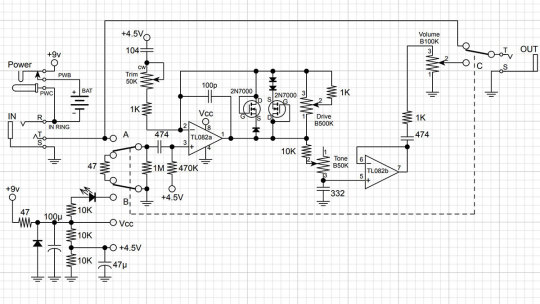
First, the limiter is included in the operational amplifier feedback, that is, between the output and the inverting input, not between the output and virtual ground. That is, here we have a soft limiter.
Secondly, one diode is added in series with each MOSFET. Clipping remains asymmetric: we have one diode in the left arm of the limiter and two diodes in the right arm.
Third, the second operational amplifier is used as a voltage repeater, aka buffer: the output is directly connected to the inverting input.
Fourth, the tone control is implemented a little differently: two OCD`s switchable resistors are replaced by a potentiometer.
And finally, the most critical, fifth difference. A potentiometer is included in the tone correction circuit between the inverting input of the first operational amplifier and the artificial midpoint.
This fourth knob, Voicing, or Character, allows you to smoothly adjust the lower frequencies in the overdrive structure over a wide range, similar to the Resonance control on many tube guitar amps.
The potentiometer is signed as a trimmer in the diagram because some pedal makers don't want to install a fourth knob on the pedal`s body. This is what Landtone did when developing the Phoenix Song Overdrive DIY kit.
The developer suggests installing the trimmer on the PCB, and to access it, you need to disassemble the pedal by unscrewing the footswitch nut and taking out the PCB.
But I will not be lazy to drill an extra hole in the pedal body and install a potentiometer with a knob, connected to PCB by wires instead of the trimmer. Because I consider this regulator simply invaluable and irreplaceable.
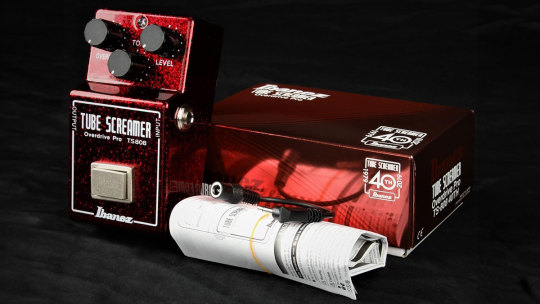
Before we get to assembly and testing, let's look at another pedal with a similar adjustment. However, it is based not on the Fulltone OCD but on the Ibanez Tube Screamer.
The Precision Drive

This is a signature pedal by Misha Mansour of Periphery, manufactured by Horizon Devices. Compared to the original Overdrive Pro TS808, the circuit adds a noise suppressor, which we will not consider, and an exciting ATTACK switch.
The Precision Drive scheme was studied and partially replicated by PedalPCB and PCB Guitar Mania. They are manufacturers of DIY kits for guitarists. Their products are called Dwarven Hammer and Collision Drive, respectively. A noise gate is not provided there, but the attack switch is implemented. This is the main difference between Precision Drive and many other overdrive pedals.
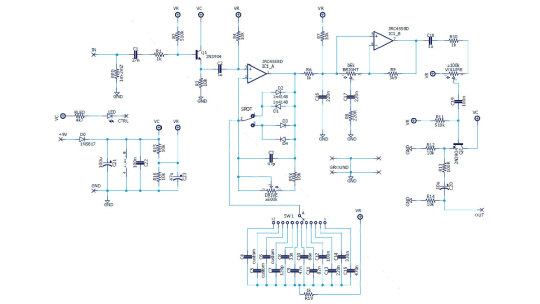
In the Fulltone OCD schematic, we saw a resistor switch at the tone shaping circuit in the output section. The Zendrive has a variable resistor in the preamp's RC circuit which is controlling the overdrive structure.
Precision Drive has a constant resistor in the same place, between the inverting input of the overdrive section operational amplifier and the virtual ground, but the capacitors are switched.
This is the same thing: we change the time constant of the RC circuit, which adjusts the audio signal's frequency spectrum. At the same time as the time constant, the complex impedance changes, thus the gain.
A resistor is a resistance to both DC and AC current. At the same time, a capacitor is only resistant to AC current because DC current does not flow through a capacitor. Since DC current does not flow through our RC circuit, there is no difference between adjusting the resistance and switching the capacitance.
But the active/reactive ratio affects the circuit's Quality factor, i.e., its resonance. It's no coincidence that the knob on guitar amplifiers, which adjusts the same frequencies as our potentiometer or switch, is often called RESONANCE. And it is used to adjust to the resonance of the electromechanical system - the loudspeakers in the cabinet, along with the masses of air in and around it.
The reactive impedance accumulates energy and gives it away, except for losses due to dielectric recharging and magnetizing the magnetic core in inductors. This is why coreless inductors are often used in high-end equipment, so-called air inductors. They weigh a lot, take up a lot of space, and are expensive because copper is more expensive than steel. But these are the laws of physics on which technology is based.
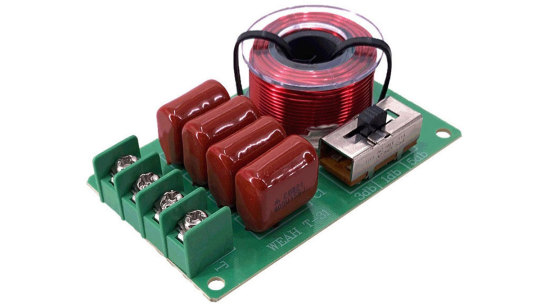
Unlike reactive impedance, active resistance converts electrical energy into heat, thus reducing the Q-factor. In some cases, it is necessary and useful. In others, it is harmful. Or it simply creates a unique sound character.
That's why switching capacitors and turning the potentiometer knob in the feedback circuit of an audio frequency amplifier is almost the same thing, but not quite. And it's great that there are such different variants of guitar overdrive pedals!
Landtone Phoenix Song Overdrive
Now you can hear how my Zendrive from the Landtone OD-1 kit sounds, with a Seymour-Duncan SH4 humbucker on a Gibson MM Explorer guitar, into an Orange MT20 with a Torpedo Captor X. And see how I assembled the pedal and also a kitten walking around the table and prancing around.
youtube
I liked the pedal, especially its fourth magic Voicing knob, which does things to the sound that other tone controls can't. I also liked the bird on the body. Because I love birds. And in the music world, the decoration of instruments and hardware plays no small role because it inspires creativity. And the fact that the pedal is assembled by my hands also warms my soul and creates inspiration.
3 notes
·
View notes
Text
okay okay okay. I'm gonna try to represent this as best I can, but I don't have access to my EWDs so I'm gonna have to do it from memory

this is an example of a very simple circuit. it has:
A power source (the horizontal lines on the left represent a battery)
A protection device (the 20 amp fuse, represented by a box with a diagonal line)
A control device (the switch, currently open, represented by a line between two dots)
A load (the thing doing the actual work, in this case a light bulb represented by a circle with a swirl)
And a ground path (represented by the horizontal lines on the right. The ground returns to the negative side of the battery but for the purposes of compactness wiring diagrams are usually drawn with them terminating at the bottom)
If you want to power multiple loads from the same power source, you can run the circuit in either series or parallel. In a series circuit, loads are placed one after another on the same wire. This reduces wire length, but the loads have to share the same voltage, and so the output of each is reduced. We're gonna focus on parallel for right now because that's what most wiring harnesses are
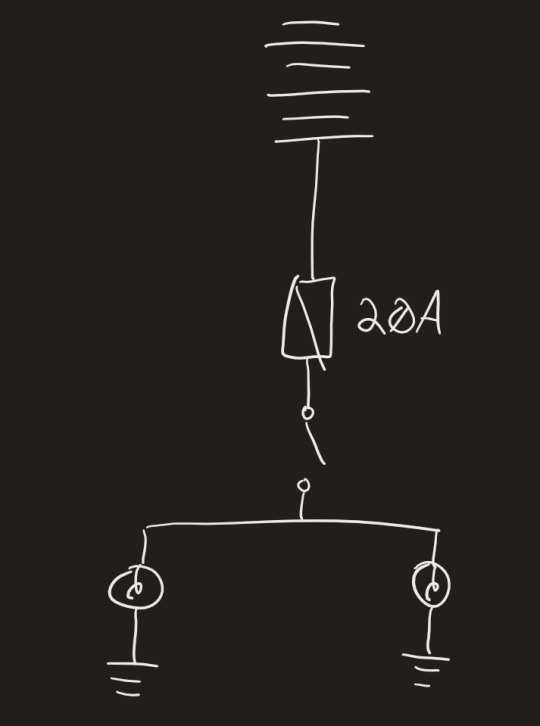
This is a parallel circuit. The wires from the battery go to two separate bulbs. The benefit of a parallel circuit is that both bulbs will get the same amount of power (it has to do with voltages and amperage and some annoying math so it doesn't violate conservation of energy). These are good because it means a break in one of the sub-circuits won't affect the operation of the other bulb. But a break in the master circuit will take out both bulbs
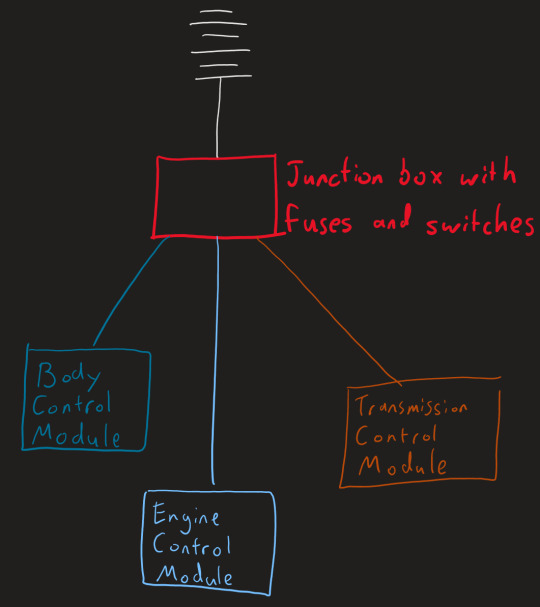
This is a basic overview of how wiring harnesses work in a vehicle. You can see that all the modules are wired in parallel, so if one goes down it doesn't take out the rest of them

If we zoom in on, say, the BCM, we can see that it controls a number of different actuators, motors, and sensors

If we zoom in further, we can see that the seatbelt ECU (Electronics Control Unit) is connected to the actual sensor itself with 3 wires: Power (red), Signal (green), and Ground (white). Many circuits are much more complicated than this (for example, the starter circuit), but this is the basic layout of the circuit heirarchy found in every harness in your vehicle.

This is what the geniuses at Tesla are trying to do. As you can see, a break anywhere on this big loop will knock out power to every single system on it, because they'll all simultaneously lose their ground. The reason they need 48 volts instead of the typical 12 is because running everything in series means each bulb, motor, sensor, whatever, is going to run at reduced power. it's a disaster of electrical wiring and is the sign of someone who wants to be different for the sake of being different. There's a reason we structure vehicle electronics the way we do








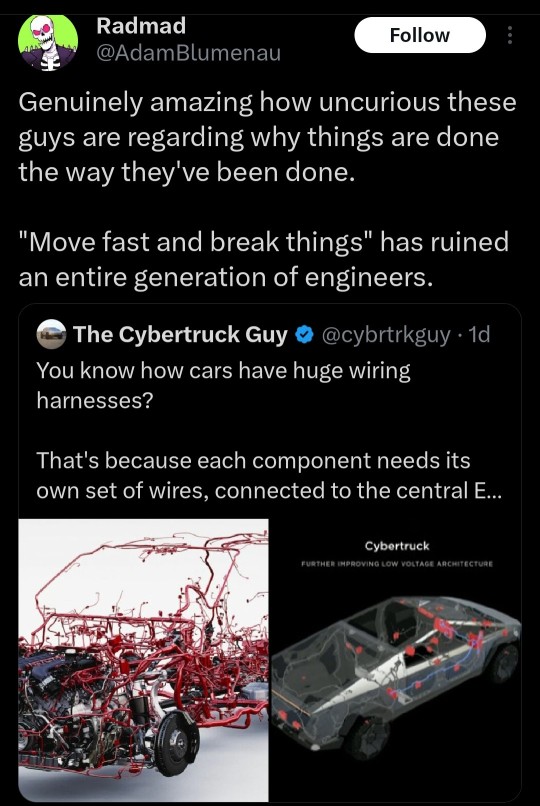
42K notes
·
View notes
Text
LED Shunt Surge Protection Device Market: Dynamics and Share Insights in 2025–2032

MARKET INSIGHTS
The global LED Shunt Surge Protection Device Market size was valued at US$ 156 million in 2024 and is projected to reach US$ 267 million by 2032, at a CAGR of 8.0% during the forecast period 2025-2032.
LED Shunt Surge Protection Devices (SPDs) are critical components designed to protect LED lighting systems from voltage spikes and transient surges. These devices work by diverting excess electrical energy away from sensitive LED circuits, preventing damage from lightning strikes, power grid fluctuations, and electrostatic discharge. The product range includes multiple voltage variants such as 6V, 9V, 13V, and 18V models catering to different LED applications.
The market growth is primarily driven by the rapid adoption of LED lighting across commercial and industrial sectors, coupled with increasing regulatory requirements for electrical safety. While street lighting applications dominate demand, emerging technologies like smart city infrastructure and industrial IoT are creating new opportunities. Recent industry developments include Eaton’s 2023 launch of their next-gen SPD series with enhanced clamping voltage performance, reflecting the ongoing technological advancements in this space.
MARKET DYNAMICS
MARKET DRIVERS
Rising Adoption of LED Lighting Systems to Accelerate Demand for Surge Protection
The global transition toward energy-efficient lighting solutions is driving substantial demand for LED shunt surge protection devices. With LED lighting systems accounting for over 50% of global lighting installations in 2024 compared to just 15% in 2015, the need for reliable surge protection has become critical. These devices protect sensitive LED components from voltage spikes caused by lightning strikes or power grid fluctuations, which can otherwise cause catastrophic failure. Municipalities worldwide are prioritizing LED streetlight conversions due to their 60-70% energy savings, creating a parallel need for robust surge protection infrastructure.
Increasing Industrial Automation to Fuel Market Expansion
Industrial facilities are increasingly integrating LED-based machine vision systems, process indicators, and industrial lighting, all requiring protection from electrical transients. Predictive maintenance strategies now incorporate surge protection as a standard specification, particularly in industries with critical manufacturing processes. The global industrial automation market, valued at approximately $200 billion in 2024, continues to expand at nearly 9% CAGR, directly correlating with higher demand for LED protection solutions. Modern surge protection devices now feature real-time monitoring capabilities, allowing facilities to preemptively address potential electrical disturbances.
Stringent Safety Regulations to Stimulate Market Growth
Governments and international standards organizations have implemented rigorous electrical safety requirements for commercial and industrial lighting installations. Recent updates to IEC 61643 standards specifically address surge protection for LED systems, compelling manufacturers to integrate protection devices at the design stage. Insurance providers now frequently mandate surge protection as part of risk mitigation strategies, particularly for high-value LED installations in retail spaces and commercial buildings. This regulatory push has transformed surge protection from optional to essential across multiple application segments.
MARKET RESTRAINTS
Price Sensitivity in Emerging Markets to Limit Adoption Rates
While developed markets readily adopt advanced surge protection solutions, price sensitivity in developing economies presents a significant barrier. In cost-driven markets, buyers often prioritize initial purchase price over long-term protection benefits, leading to suboptimal protection solutions or complete omission of surge devices. The economic disparity between regions creates a bifurcated market landscape, with sophisticated solutions in developed nations competing against low-cost alternatives in developing economies. This price differential can reach 300-400% for comparable protection technologies, forcing manufacturers to develop region-specific product strategies.
Technical Limitations in High-Frequency Protection to Challenge Manufacturers
Modern LED drivers operate at increasingly high switching frequencies, requiring surge protectors with nanosecond response times. Existing technologies face physical limitations in achieving both fast response and high energy absorption capabilities. Advanced protection devices capable of handling these extreme conditions often incur 40-50% higher production costs compared to conventional solutions. These technical constraints particularly impact protection for high-end LED video walls and specialized industrial lighting where transient events can occur at frequencies exceeding 1MHz.
Other Restraints
Supply Chain Vulnerabilities The semiconductor materials essential for high-performance surge protectors face periodic shortages, disrupting production schedules. Reliance on specialized components from limited suppliers creates bottlenecks in the manufacturing process.
Installation Complexity Proper integration of shunt protection requires technical expertise often lacking in general electrical contracting teams. Improper installation can negate protection benefits while creating potential liability issues.
MARKET OPPORTUNITIES
Smart City Initiatives to Create New Revenue Streams
Global smart city investments are projected to exceed $1 trillion by 2030, with intelligent lighting infrastructure representing a significant portion. These advanced systems require surge protection solutions with IoT connectivity for remote monitoring and predictive maintenance. Leading manufacturers are developing cloud-connected protection devices that integrate with city management platforms, creating recurring revenue opportunities through monitoring services. The convergence of 5G deployment with smart lighting further enhances the potential for sophisticated protection ecosystems in urban environments.
Electric Vehicle Infrastructure Expansion to Drive Demand
The rapid growth of EV charging stations, expected to surpass 40 million units globally by 2030, presents a substantial adjacent market for LED surge protection. Charging stations incorporate numerous LED indicators and display systems vulnerable to electrical transients. Protection device manufacturers are adapting existing technologies to meet the unique requirements of high-power charging environments, including enhanced EMI suppression and wider operating temperature ranges. Strategic partnerships between surge protection specialists and charging infrastructure providers are becoming increasingly common.
MARKET CHALLENGES
Miniaturization Requirements to Challenge Engineering Teams
As LED components shrink in size, surge protection devices must follow suit without compromising performance. Modern LED modules often have less than 5mm clearance for additional components, creating severe spatial constraints. Engineering teams struggle to balance physical size reduction with maintaining necessary protection levels, requiring innovative approaches to heat dissipation and arc suppression. These challenges are particularly acute in automotive LED applications where protection devices must withstand harsh environmental conditions in extremely compact form factors.
Lack of Standardized Testing Protocols to Create Market Confusion
The industry currently lacks universally accepted testing methodologies for evaluating surge protection performance in LED-specific applications. Various manufacturers employ different stress test conditions, making direct product comparisons difficult for specifiers. This inconsistency leads to confusion in the procurement process and potential mismatches between protection levels and actual application requirements. Industry consortiums are working to establish standardized testing procedures, but interim solutions require thorough technical evaluation by lighting system designers.
Other Challenges
Lifespan Mismatch LED systems typically offer 50,000+ hour lifespans, while some surge protection components degrade faster, requiring replacement midway through the LED product life cycle.
Counterfeit Components The proliferation of counterfeit semiconductor devices in the supply chain compromises the reliability of protection solutions, creating safety risks and brand reputation concerns.
LED SHUNT SURGE PROTECTION DEVICE MARKET TRENDS
Rising Demand for Energy-Efficient Lighting Solutions Drives Market Growth
The global shift toward energy-efficient lighting solutions has significantly boosted the adoption of LED shunt surge protection devices (SPDs). With the LED lighting market projected to reach $105 billion by 2030, manufacturers are prioritizing robust protection mechanisms to enhance product longevity. Recent studies indicate that nearly 40% of premature LED failures stem from voltage surges, creating substantial demand for advanced SPD solutions. Leading manufacturers are responding with smaller, more efficient shunt devices that offer superior clamping voltage performance while reducing power dissipation by up to 30% compared to conventional models. This technological evolution aligns with stringent international standards such as IEC 61643-11, further validating product reliability in commercial and industrial applications.
Other Trends
Integration with Smart City Infrastructure
Smart city initiatives worldwide are accelerating deployments of intelligent LED street lighting systems, creating parallel demand for sophisticated surge protection. Municipalities increasingly specify Type 1+2 combined SPDs capable of handling direct lightning strikes (10/350µs waveform) and secondary surges (8/20µs waveform). The Asia-Pacific region demonstrates particularly strong growth, where countries like China and India are installing over 50 million smart streetlights annually. These systems require shunt devices with remote monitoring capabilities—a feature now offered by 60% of major manufacturers—to enable predictive maintenance and reduce municipal operating costs.
Miniaturization and Higher Voltage Tolerance Shape Product Development
Component miniaturization represents a critical competitive frontier in the SPD market, with leading vendors achieving 50% size reduction in next-generation 18V shunt devices while maintaining 40kA surge current ratings. This advancement directly addresses space constraints in modern LED drivers and luminaires. Simultaneously, the market observes growing adoption of higher voltage (24V+) shunt SPDs for industrial LED applications, which now constitute 25% of new product launches. These developments coincide with rising demand from the automotive sector, where electric vehicles incorporate LED lighting systems requiring specialized 12V/24V shunt protectors with automotive-grade temperature tolerances (-40°C to +125°C).
COMPETITIVE LANDSCAPE
Key Industry Players
Market Leaders Expand Product Offerings to Meet Growing Demand for Surge Protection
The global LED Shunt Surge Protection Device market features a competitive yet concentrated landscape, dominated by established electronics component manufacturers with robust technological capabilities. Littelfuse and STMicroelectronics currently lead the market, collectively holding over 30% of the global revenue share in 2024. Their dominance stems from extensive product portfolios covering multiple voltage ranges (6V to 18V) and proven reliability in industrial applications.
Infineon Technologies and Analog Devices have been gaining significant traction, particularly in the Asia-Pacific region, through strategic partnerships with LED lighting manufacturers. Both companies have invested heavily in R&D to develop compact, energy-efficient protection solutions tailored for high-density LED arrays.
The market also sees active participation from mid-sized players like Bourns and Onsemi, who differentiate through specialized offerings for niche applications such as automotive lighting and LCD backlighting. These companies are expanding their production capacities to meet the growing demand from emerging economies.
Recent developments show increasing M&A activity, with Eaton acquiring two smaller surge protection specialists in 2023 to strengthen its position in the industrial lighting segment. Such consolidation trends are expected to continue as companies seek to offer comprehensive protection solutions across the entire LED value chain.
List of Key LED Shunt Surge Protection Device Manufacturers
Littelfuse, Inc. (U.S.)
STMicroelectronics (Switzerland)
Infineon Technologies AG (Germany)
Analog Devices, Inc. (U.S.)
Bourns, Inc. (U.S.)
ON Semiconductor (U.S.)
Eaton Corporation (Ireland)
Segment Analysis:
By Type
6 Volts Segment Leads Market Demand Due to Widespread Use in Low-Voltage LED Applications
The market is segmented based on type into:
6 Volts
Subtypes: Standard, High-Performance, and Miniature
9 Volts
13 Volts
18 Volts
Others
By Application
LED Streetlights Segment Dominates with Growing Smart City Infrastructure Investments
The market is segmented based on application into:
LED Streetlights
LCD Backlighting Televisions
Industrial Lighting Lamps
Others
By Technology
Silicon-Based Devices Capture Major Market Share for Enhanced Thermal Performance
The market is segmented based on technology into:
Silicon-Based
Subtypes: Single-stage, Multi-stage
GaN-Based
Others
By Protection Voltage
Low-Voltage Protection Segment Shows Strong Growth in Consumer Electronics
The market is segmented based on protection voltage into:
Below 50V
50-100V
Above 100V
Regional Analysis: LED Shunt Surge Protection Device Market
North America The North American market is characterized by strong technological adoption and stringent safety regulations, particularly in the U.S. and Canada. With infrastructure upgrades and smart city initiatives gaining momentum, demand for LED shunt surge protection devices is growing steadily—especially for applications like LED streetlights and industrial lighting. The U.S. accounts for over 70% of the regional market share, driven by energy efficiency mandates and investments in urban lighting modernization programs. Additionally, the presence of key manufacturers, such as Littelfuse and Eaton, contributes to localized R&D and innovation in surge protection. However, high costs of advanced solutions may slow adoption in price-sensitive sectors.
Europe Europe’s market is shaped by strict electrical safety standards (EN 61643) and growing adoption of energy-efficient lighting solutions. Germany and France lead in terms of market penetration, supported by government policies favoring sustainability. Across the region, compliance with CE and RoHS directives is critical, pushing manufacturers to develop eco-friendly surge protection components. The shift toward smart lighting in commercial and residential applications further propels demand, though competition from Asian suppliers has intensified pricing pressures. The EU’s focus on reducing electronic waste also encourages innovation in long-lasting surge protection technologies.
Asia-Pacific Asia-Pacific dominates the global market, accounting for nearly 45% of total revenue, with China, Japan, and South Korea as primary contributors. Rapid urbanization and investments in public infrastructure—such as highways and smart cities—are accelerating demand for LED shunt surge protection devices. China remains the largest consumer, given its massive LED production capacity and government-led initiatives for energy conservation. However, price competition is fierce, with local manufacturers emphasizing cost efficiency over premium features. India and Southeast Asia show potential with rising LED adoption, though lack of standardized regulations hampers consistent quality deployment.
South America The South American market is in its growth phase, with Brazil leading due to improving industrial and commercial lighting infrastructure. Economic instability remains a challenge, limiting large-scale investments in high-end protection devices. However, sectors like mining and outdoor lighting drive moderate demand, especially for rugged surge protection solutions. The absence of strict enforcement for surge protection standards results in a fragmented market, with imports fulfilling much of the demand. Nonetheless, partnerships between global brands and local distributors are gradually improving accessibility to advanced products.
Middle East & Africa This region exhibits nascent but promising demand, primarily in the UAE, Saudi Arabia, and South Africa. Government-led smart city projects, such as NEOM in Saudi Arabia, are creating opportunities for surge protection device suppliers. The market leans toward durable, high-temperature-resistant models suited for harsh climates, though cost sensitivity still favors budget-oriented imports. Limited local manufacturing capabilities mean dependence on foreign players, with gradual progress driven by infrastructural developments in urban centers. Long-term growth is expected as LED adoption expands beyond commercial hotspots to residential applications.
Report Scope
This market research report provides a comprehensive analysis of the global and regional LED Shunt Surge Protection Device markets, covering the forecast period 2025–2032. It offers detailed insights into market dynamics, technological advancements, competitive landscape, and key trends shaping the industry.
Key focus areas of the report include:
Market Size & Forecast: Historical data and future projections for revenue, unit shipments, and market value across major regions and segments. The Global LED Shunt Surge Protection Device market was valued at USD 220 million in 2024 and is projected to reach USD 350 million by 2032, growing at a CAGR of 6.1%.
Segmentation Analysis: Detailed breakdown by product type (6 Volts, 9 Volts, 13 Volts, 18 Volts, Others), application (LED Streetlights, LCD Backlighting Televisions, Industrial Lighting Lamps, Others), and end-user industry to identify high-growth segments and investment opportunities. The 6 Volts segment accounted for 32% market share in 2024.
Regional Outlook: Insights into market performance across North America, Europe, Asia-Pacific, Latin America, and the Middle East & Africa, including country-level analysis where relevant. Asia-Pacific holds 45% market share, driven by China’s LED manufacturing dominance.
Competitive Landscape: Profiles of leading market participants including Analog Devices, Bourns, Eaton, Infineon Technologies, Littelfuse, Onsemi, and STMicroelectronics, covering their product offerings, R&D focus, manufacturing capacity, pricing strategies, and recent developments.
Technology Trends & Innovation: Assessment of emerging technologies in surge protection, integration with smart lighting systems, and evolving industry standards for LED protection devices.
Market Drivers & Restraints: Evaluation of factors driving market growth (increasing LED adoption, smart city initiatives) along with challenges (price volatility of raw materials, stringent regulations).
Stakeholder Analysis: Insights for component suppliers, OEMs, system integrators, investors, and policymakers regarding the evolving ecosystem and strategic opportunities in LED protection solutions.
Related Reports:https://semiconductorblogs21.blogspot.com/2025/06/global-video-sync-separator-market.htmlhttps://semiconductorblogs21.blogspot.com/2025/06/silicon-rings-and-silicon-electrodes_17.htmlhttps://semiconductorblogs21.blogspot.com/2025/06/ceramic-bonding-tool-market-investments.htmlhttps://semiconductorblogs21.blogspot.com/2025/06/coaxial-panels-market-challenges.htmlhttps://semiconductorblogs21.blogspot.com/2025/06/oled-and-led-automotive-light-market.htmlhttps://semiconductorblogs21.blogspot.com/2025/06/gas-cell-market-demand-for-ai-chips-in.htmlhttps://semiconductorblogs21.blogspot.com/2025/06/digital-demodulator-ic-market-packaging.htmlhttps://semiconductorblogs21.blogspot.com/2025/06/nano-micro-connector-market.htmlhttps://semiconductorblogs21.blogspot.com/2025/06/single-mode-laser-diode-market-growth.htmlhttps://semiconductorblogs21.blogspot.com/2025/06/silicon-rings-and-silicon-electrodes.htmlhttps://semiconductorblogs21.blogspot.com/2025/06/battery-management-system-chip-market.htmlhttps://semiconductorblogs21.blogspot.com/2025/06/scanning-slit-beam-profiler-market.htmlhttps://semiconductorblogs21.blogspot.com/2025/06/atomic-oscillator-market-electronics.htmlhttps://semiconductorblogs21.blogspot.com/2025/06/plastic-encapsulated-thermistor-market.htmlhttps://semiconductorblogs21.blogspot.com/2025/06/ceramic-bonding-tool-market-policy.html
0 notes
Text
48V Surge Protection Solution with Polarity Reverse Connection Protection — Differential and Common Mode
DC48V power supplies are widely used in industrial automation (motor drives/industrial robots), transportation infrastructure (charging piles/vehicle electronics), security systems (surveillance cameras/access control systems), and energy storage devices (BMS/off-grid controllers) due to their Safety Extra-Low Voltage (SELV, ≤60V) characteristics.
Leiditech Electronics has customized and developed a differential and common mode surge protection solution with polarity reverse connection protection based on standards such as IEC 61000–4–2, EN 61000–4–2, GB/T 17626.2, IEC 61000–4–5, EN 61000–4–5, and GB/T 17626.5. This solution prevents equipment failures caused by static electricity, surges, reverse polarity connections, etc.
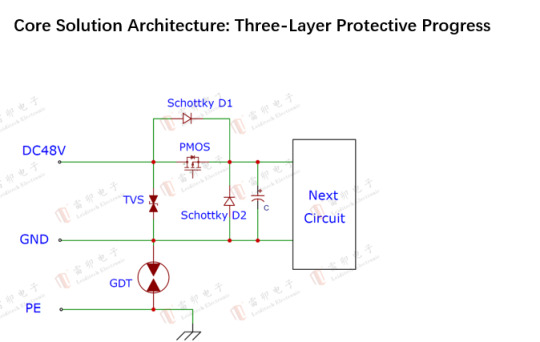
l Leiditech uses TVS devices with ±5% voltage accuracy and a response time of <1ns to provide precise overvoltage protection for the rear-end circuits. These devices can clamp the peak value of 8/20μS surges to ≤93.6V (typical value), preventing precision components such as rear-end MCUs and sensors from being damaged by overvoltage breakdown. They support multi-power level selection from 400W to 15kW, adapting to different risk scenarios indoors and outdoors.
l A PMOS tube or a low-voltage-drop Schottky diode is connected in series at the rear stage of the TVS tube for polarity reverse-connection protection. The power loss of the low internal resistance PMOS tube is 60% lower than that of traditional diodes, making it suitable for high-power systems above 20A; a low VF Schottky diode is connected in parallel near the chip terminal for negative voltage surge protection.
l Leiditech provides an efficient surge current discharge path by connecting a ceramic gas discharge tube (GDT) in parallel between GND and PE. If the product involves insulation withstand voltage testing, the rated voltage of the GDT can be increased to simultaneously meet the requirements of withstand voltage and surge protection.
l A low VF Schottky diode is connected in parallel at the power input end of the chip to provide a fast discharge path for negative voltage interference.
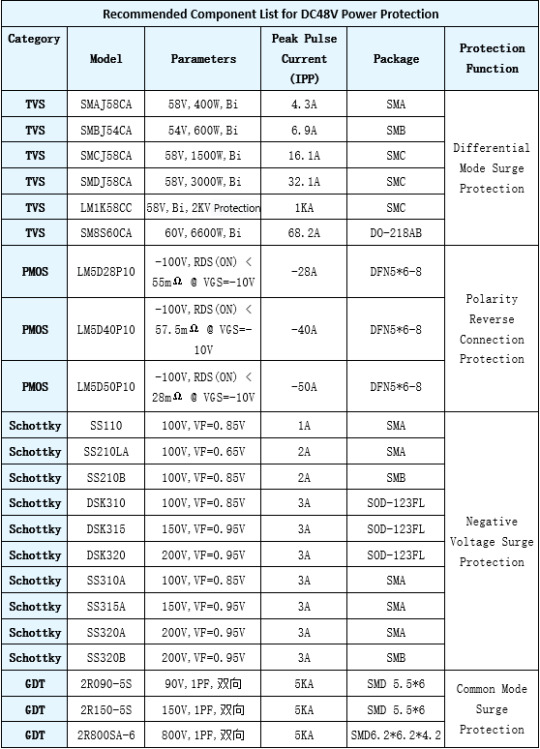
Additional Services and Capabilities
l EMC Laboratory Support: Leiditech’s self-built EMC laboratory provides free testing for static electricity, surges, EFT, etc., to accelerate solution verification.
l Customization Services: Parameters and packages can be customized for special scenarios such as high voltage and high frequency.
l Comprehensive Protection Solutions: For “zero-fault” scenarios, a combined PTC+TVS+ESD solution is offered to cover multiple risks including overvoltage, overcurrent, and static electricity.
Leiditech Electronics is committed to becoming a leading brand in electromagnetic compatibility (EMC) solutions and component supply. We offer a wide range of products, including ESD, TVS, TSS, GDT, MOV, MOSFET, Zener diodes, and inductors. With an experienced R&D team, we provide personalized customization services to deliver the highest quality EMC solutions tailored to our customers’ needs.
If you’d like to learn more or have any questions, don’t hesitate to reach out:
Visit us at [en.leiditech.com]
0 notes
Text
The Building Blocks of Electrical Engineering: What Every Student Should Master
A solid grounding in the fundamentals is essential for every aspiring electrical engineer. Mastery of these core concepts not only enables effective problem-solving and innovation but also forms the basis for all advanced studies and professional success in the field.
Core Principles and Laws
Ohm’s Law: This fundamental law relates voltage, current, and resistance in a circuit. It states that the voltage across a conductor is directly proportional to the current flowing through it, provided the physical conditions remain constant (V = I × R).
Kirchhoff’s Laws:
Kirchhoff’s Current Law (KCL): The total current entering a junction equals the total current leaving it.
Kirchhoff’s Voltage Law (KVL): The algebraic sum of all voltages around any closed loop in a circuit is zero.
Network Theorems: Thevenin’s and Norton’s theorems are essential for simplifying complex circuits and analyzing their behavior.
Basic Electrical Quantities
Current (I): The flow of electric charge, measured in amperes. It is the movement of electrons through a conductor.
Voltage (V): The electrical potential difference that drives current through a circuit, measured in volts.
Resistance (R): The opposition to current flow, measured in ohms. It depends on the material, length, and cross-sectional area of the conductor.
Power (P): The rate of energy transfer in a circuit, calculated as P=IVP=IV, measured in watts.
Circuit Elements and Analysis
Passive Elements: Resistors, capacitors, and inductors, which absorb or store energy but do not generate it.
Active Elements: Voltage and current sources that supply energy to the circuit.
Series and Parallel Circuits: Understanding how components behave in series (same current, voltage divides) and parallel (same voltage, current divides) is crucial for circuit analysis.
Star-Delta Transformation: A technique for simplifying complex resistor networks.
Types of Circuits
DC Circuits: Circuits powered by a constant direct current source. Analysis involves the steady-state behavior of resistors, capacitors, and inductors.
AC Circuits: Circuits powered by alternating current sources. Analysis includes understanding reactance, impedance, and phase relationships.
Single-phase and Three-phase Systems: Essential for understanding power distribution and the operation of industrial equipment.
Electromagnetism and Machines
Electromagnetic Principles: Understanding magnetic fields, flux, and electromagnetic induction is foundational for working with motors, generators, and transformers.
Transformers: Devices that transfer electrical energy between circuits through electromagnetic induction. Key for voltage conversion and power distribution.
Motors and Generators: Machines that convert electrical energy to mechanical energy (motors) and vice versa (generators). Knowledge of their principles and operation is vital.
Measurement and Instrumentation
Measuring Instruments: Familiarity with devices like voltmeters, ammeters, and multimeters is essential for practical circuit analysis and troubleshooting.
Power Factor: Understanding and improving power factor is important for efficient energy use in AC systems.
Mathematics and Physics Foundations
Mathematics: Proficiency in calculus, trigonometry, and differential equations is necessary for modeling and analyzing electrical systems.
Physics: Concepts from electromagnetism and basic mechanics underpin much of electrical engineering theory and practice.
Digital and Analog Systems
Analog Circuits: Continuous signal processing; involves resistors, capacitors, inductors, and transistors.
Digital Circuits: Discrete signal processing; involves logic gates, memory systems, and microcontrollers.
Embedded Systems: Integration of hardware and software for intelligent electronic solutions.
Practical Skills and Lifelong Learning
Circuit Design and Simulation: The Ability to design, analyze, and simulate circuits using modern tools is crucial for both academic and professional success.
Project-Based Learning: Hands-on experience through projects enhances understanding and develops problem-solving skills.
Continuous Learning: The rapid evolution of technology in electrical engineering demands ongoing education and adaptability.
Concept/Area
Why It’s Essential
Ohm’s Law, KCL, KVL
Foundation for circuit analysis and design
Circuit Elements
Understanding the behavior and function of components
AC/DC Circuits
Basis for power systems, electronics, and signal processing
Electromagnetism
Underpins the operation of machines, transformers, and communication systems
Measurement & Instrumentation
Enables accurate analysis and troubleshooting
Mathematics & Physics
Provides tools for modeling and solving engineering problems
Analog & Digital Systems
Core to modern electronics and embedded systems
Lifelong Learning
Ensures relevance and adaptability in a fast-evolving field
Summary Table: Key Concepts and Their Importance
Conclusion
Mastering these fundamentals equips electrical engineering students to analyze, design, and maintain the systems that power modern society. Arya College of Engineering & I.T. is the best college of Jaipur which has a deep understanding of these core concepts fosters innovation, supports professional growth, and prepares students for the diverse challenges of an ever-evolving field.
0 notes
Text
Instrument Rental for Engineers: Choosing the Right Electrical Measuring Devices
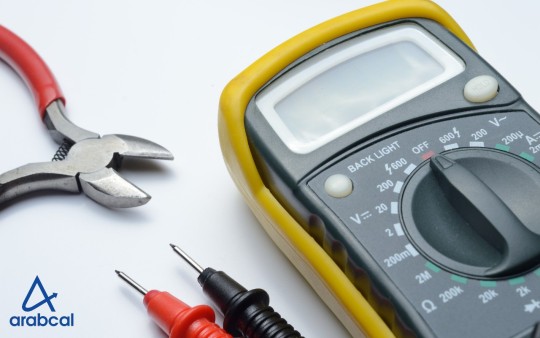
Electrical measurement devices are vital for assessing, tracking, and evaluating electrical circuits and systems. These tools are key to ensuring the safety, precision, and optimal performance of electrical operations across industries such as construction, manufacturing, and electrical engineering. For top-quality electrical measuring instruments, Arabcal provides reliable and accurate tools to meet all your measurement needs, ensuring superior performance and safety in every application.
This blog will guide you through various types of electrical measuring devices, including the multimeter, ammeter, voltmeter, and wattmeter
Let’s explore their practical uses and learn how to operate these measuring devices properly to ensure precise results.
1. Multimeter
Multimeters are among the most widely utilized electrical testing instruments in labs. They are capable of measuring various electrical parameters such as voltage, current, and resistance. These devices are frequently employed for diagnosing issues and performing upkeep on electrical systems.
2. Ammeter
An ammeter is used to measure the flow of direct or alternating current within an electrical circuit. The measurement is expressed in Amperes (A). Ammeters are installed in series with the circuit to ensure accurate readings. They are designed with very low resistance to permit a high current flow. Ammeters are capable of detecting a wide spectrum of current levels.
When the current to be measured is in milliamps or microamps, specialized instruments called microammeters or milliammeters are used. There are two primary types of ammeters – analog and digital. Analog ammeters display the current using a pointer and scale, while digital ammeters show the reading on a digital screen.
3. Voltmeter
A voltmeter is used to measure the voltage or electrical potential difference between two points in an electrical circuit. Voltage is expressed in volts. Voltmeters are generally connected in parallel with the component or circuit being measured and are designed with very high resistance to limit the current flow through the circuit.
Commercial voltmeters typically use an electromechanical system where the current is converted into voltage before being measured. In contrast, electrostatic voltmeters directly measure the voltage. Similar to ammeters, voltmeters come in two types – analog and digital.
4. Wattmeter
A wattmeter is used to measure the power or the rate at which energy is consumed in an electrical circuit. Power is expressed in watts (W). Wattmeters are commonly employed in three-phase systems to measure both apparent and real power in a circuit. They are also useful for assessing power supply efficiency and calculating energy costs.
Wattmeters are connected in such a way that they measure both the current and voltage in the circuit, then compute the power using the formula P = VI (where P is power, V is voltage, and I is current). These devices are often used to track the power consumption of appliances and evaluate the output power from generators and other energy sources.
How to Select the Right Electrical Instrument?
It’s also crucial to take into account the measurement range that the instrument can handle. Some devices offer a broad range of measurements, while others are limited to a narrower scope. Furthermore, the accuracy of the instrument is an important factor. The greater the accuracy, the more precise the readings will be.
It’s essential to remember that to achieve precise measurements, the appropriate range or sensitivity of the meter should be chosen. For instance, using a meter with a low range to measure a high current will result in inaccurate readings. Similarly, using a meter with a high range to measure a low voltage will also lead to unreliable results.
When operating these instruments, it's crucial to adhere to proper safety guidelines to safeguard both yourself and the equipment. This involves making sure the circuit is powered off before connecting any devices, and wearing the correct personal protective gear, such as rubber gloves and safety goggles.
Conclusion
In summary, electrical measurement devices are crucial for maintaining the safe and effective functioning of electrical systems. By familiarizing yourself with the specific features and functions of these instruments, you can make a well-informed choice when selecting the right tool for your needs. With a broad range of options available, including voltmeters, ammeters, wattmeters, and clamp meters, there’s an electrical measuring instrument suited to your particular requirements. For reliable instrument rental UAE, Arabcal offers top-quality tools and equipment for all your electrical measurement needs.
#tester equipment supplier uae#megger service center#instrument and equipment supplier in uae#iso 17025 accredited calibration company in uae#calibration#biomedical test equipment#asset management in uae
0 notes
Text
How to Effectively Use LM4040 in Your PCB Designs
Ever tried building a stable electronic circuit, only to find your voltage levels jumping all over the place? It's like trying to paint a masterpiece while your canvas keeps moving. That’s where the LM4040 comes in—a small but mighty tool that helps you create smooth, reliable voltage references in your PCB designs.
If you're wondering how to use this component without needing an engineering degree, don’t worry. In this guide, I’ll walk you through the LM4040 in plain English. You’ll learn how it works, why it's essential, and how to integrate it into your projects effortlessly.
What is the LM4040?
Think of the LM4040 as a “voltage anchor.” It’s a precision voltage reference IC that provides a stable and fixed voltage, no matter what’s going on in the rest of your circuit.
This little device is commonly used when you need a reliable point of reference—just like a compass pointing north.
Why Voltage References Matter in Electronics
Imagine trying to measure ingredients without a proper measuring cup. That’s what working without a voltage reference feels like. In electronics, especially in analog circuits and ADCs (Analog-to-Digital Converters), having a stable voltage is crucial.
Voltage references help ensure:
Accurate measurements
Consistent output performance
Protection from voltage fluctuations
Key Features of the LM4040
Here’s why the LM4040 stands out:
High accuracy (±0.1% and ±0.2% versions available)
Low temperature coefficient (good performance even in hot or cold)
Micropower operation (as low as 60 µA)
Available in multiple voltages (2.5V, 4.096V, 5.0V, etc.)
Compact packaging (SOT-23, TO-92)
It’s like having a smart assistant that keeps your voltage levels steady without needing much attention.
Different Variants and Voltage Options
The LM4040 series comes in a range of preset voltage options:
LM4040AIZ-2.5 (2.5V)
LM4040AIZ-4.1 (4.096V)
LM4040AIZ-5.0 (5.0V)
Choosing the right one depends on your circuit's requirements. For example, if you're feeding an ADC that needs a 2.5V reference, the LM4040AIZ-2.5 is your go-to.
How the LM4040 Works: A Simple Explanation
Here’s a metaphor: Think of the LM4040 as a traffic cop that controls the voltage flow. It doesn’t let the voltage go over or under a certain level—it just keeps it steady.
Technically, it's a shunt regulator. That means you connect it in parallel with your load, and it maintains a constant voltage by “shunting” extra current.
LM4040 vs Zener Diodes: What’s the Difference?
Many beginners ask, “Why not just use a Zener diode?”
While Zener diodes are cheaper, they:
Are less accurate
Have higher temperature drift
Need more current to operate
The LM4040 offers better stability, accuracy, and efficiency, making it a solid upgrade from traditional Zener solutions.
Ideal Applications for LM4040
You’ll find the LM4040 in all sorts of electronics, especially where precision matters:
Battery-powered devices
Analog-to-digital converters (ADCs)
Microcontroller references
Instrumentation circuits
Sensor calibration systems
It’s like the backbone of any circuit that needs consistency.
How to Connect LM4040 in Your PCB
Connecting the LM4040 is straightforward. Here’s how you do it:
Cathode to positive supply
Anode to ground
Resistor in series with supply (sets current)
Make sure the current flowing through it stays within the recommended range (typically 60 µA to 15 mA). This ensures optimal performance.
Choosing the Right Resistors for LM4040
Resistor selection is critical.
Use Ohm’s Law: R = (Vin - Vref) / I
Let’s say Vin is 9V and you use a 5V LM4040. Targeting 1mA current:
R = (9V - 5V) / 0.001A = 4000 ohms (or 4kΩ)
Pick a standard resistor close to this value—maybe 3.9kΩ or 4.3kΩ, depending on tolerances and your desired accuracy.
Layout Tips for Clean PCB Design
PCB layout affects the performance of precision components like the LM4040. Follow these tips:
Keep traces short and wide
Use a solid ground plane
Avoid routing noisy signals nearby
Decouple with a small capacitor if needed (0.1µF)
Think of it like building a house—you need a solid foundation and clean wiring.
Common Mistakes to Avoid
Here are a few gotchas:
Wrong resistor value: Can cause under-voltage or overcurrent
Exceeding power dissipation: The IC can heat up and drift
Bad grounding: Can cause noise issues and unstable output
Double-check your datasheet and simulation before building.
Troubleshooting LM4040 in a Circuit
If your LM4040 isn’t behaving as expected:
Check input voltage—is it too low?
Measure resistor value—was it soldered right?
Look for shorts or poor solder joints
Use an oscilloscope to spot ripple or noise
Most issues boil down to simple mistakes. A multimeter can be your best friend here.
Practical Example: Battery Monitor Circuit
Imagine building a battery monitor with an Arduino. The ADC needs a stable reference voltage to detect when your battery drops below a certain level.
Using the LM4040AIZ-2.5, you feed a steady 2.5V to the reference pin. This gives consistent and reliable ADC readings—even if your battery voltage fluctuates.
LM4040 in DIY Projects: Real-World Ideas
Still wondering where you can use the LM4040 in your DIY adventures? Try these:
Solar-powered weather stations
Portable medical devices
Audio circuits for cleaner signals
Custom voltmeters
Home automation systems
If you’re into microcontrollers, the LM4040 is almost like having a cheat code for better analog readings.
Final Thoughts
The LM4040 might be small, but it’s a giant when it comes to stability. Whether you're just getting started with electronics or refining a professional-grade circuit, this component adds the kind of rock-solid precision every designer craves.
Just remember—a good voltage reference isn’t a luxury, it’s a necessity. And the LM4040 delivers without drama.
0 notes
Text
This report describes a transmission line experiment. A transmission line is a means of carrying electromagnetic signals in the wave –guided wave systems. It is generally distinguished from other guided-wave systems by having two conductors. The objective of the experiment was to be familiar with the apparatus for generating and measuring the properties of ultra-high frequency (UHF) electromagnetic waves, to verify the basic properties of transmission lines as predicted by the telegrapher’s equations. Measurement of the speed of a TEM wave in a coaxial cable and exploration of standing wave patterns as a function terminating impedance was carried out. It also describes the setup of the experiment; the results were recorded, discussed and analyzed. Moreover, the errors were analyzed and discussed. The experiment was based around the HP85 slotted transmission lines. The device has a travelling probe which carries a diode; called a crystal detector that generates a DC current that depend non-linearly on the intensity of the electromagnetic field around it. Introduction A transmission line is a device that is designed to guide electrical energy from one point to another. For example, to transfer the output radio frequency energy of a transmitter to an antenna with the least possible power loss. This will depend on the special physical and electrical characteristics like impedance and resistance of the transmission line. The electrical features of a two-wire transmission line depend primarily on the construction of the line. In that the change of its capacitance reactance is recognized as the frequency applied to it is changed. Transmission line in electromagnetic is commonly used in structures which are able of guiding transverse electric and magnetic waves (TEM) (Jackson, 1975). TEM waves exist in structures that contain two or more separate conductors. Coaxial waves, parallel plates and two-wire lines are examples of practical transmission lines. Transmission lines are generally characterized by the following properties; balance –to-ground, characteristic impedance, attenuation per unit length, velocity factor and electrical length. Balance-to-ground is a measure of electrical symmetry of a transmission line with respect to ground potential. The combination of a series inductance and shunt capacitance in the two conductors gives transitional line characteristic impedance (Ramo,Whinnery, Duzer,1965). Aerials and transmission lines differ from simple electrical networks in that their inductance, capacitance and resistance are not lumped but are distributed over distances whereby the time travels is taken into consideration. It consists of an arrangement of electrical conductors by means of electromagnetic waves from one place to another (Jackson, 1975). The theory of transmission lines provides a link between circuit theory and field theory of electromagnetic waves (Ramo,Whinnery, Duzer,1965). If the series inductance per unit length of line LS and the parallel capacitance per unit length CP are known, and the loss resistance can be neglected. The characteristic impedance of transmission line will be; The attenuation per unit length measures how much of the radio frequency (RF) signal is lost per unit length of transmission line due to radiation leakages, dielectric and skin effect losses. Radiation losses occur in two wires because the fields from one line do not completely cancel out those from the other line. Radiation occurs in braided coaxial lines since the braid does not provide 100% shielding (Ramo, Whinnery, Duzer, 1965). The conductors are separated from one another by an insulating material known as a dielectric. It exhibit losses that increases as the voltage and frequency on the conductors increases. The total losses in transmission line are approximately proportional to the square root of the frequency. The radio frequency current flowing along a transmission line creates radio wave that is guided by the transmission line. The velocity will be given by the equation: Where V = the wave velocity Ls = Series inductance per unit length Cp = Parallel capacitance per unit length The wave propagation velocity of the guided wave will always be less than the speed of light in a vacuum, 300,000,000M/sec The electrical length of a cable is its length measured in wavelengths (λ) and is related to the frequency of the wave and the velocity with which it propagates along the transmission line. Transmission line constants called distributed constants are spread along the entire length of the transmission line and cannot be distinguished separately (Jackson, 1975). The amount of inductance, capacitance and resistance depends on the length of the line, the size of the conducting wires, the spacing between the wires and the dielectric between the wires. The energy produced by the magnetic lines of force collapsing back into the wire tends to keep the current flowing in the same direction. This will represent a certain amount of inductance which is expressed in microhenrys per unit length. The two parallel plates will act as plates of a capacitor and the air between acts as dielectric. It is expressed in picofarads per unit length (Ramo, Whinnery, Duzer, 1965). Conductance in transmission lines is expressed as the reciprocal of resistance and is usually expressed in micromhos per unit length. The maximum transfer of electrical energy takes place when the source impedance is matched to the load impedance (Jackson, 1975). Induction losses occur when the electromagnetic field about a conductor cuts through any nearby metallic object and the current is induced in that object, as a result power is dissipated in the object and is lost. The measurement of standing waves on a transmission line yields information about equipment operating conditions. Maximum power is absorbed by the load when Z l=Z0. (Ramo, Whinnery, Duzer, 1965). The ratio of the maximum to the minimum is a measure of the perfection of the termination of a line known as standing wave ratio (swr). The ratio of maximum voltage to minimum voltage on a line is known as voltage standing wave ratio (vswr). Therefore the equation represented as; The rigid coaxial line consists of a central, insulated wire mounted inside a tubular outer conductor. The inner conductor is insulated from the outer conductor by insulating spacers or beads at regular intervals, the spacers are made of Pyrex, polystyrene which have good insulating characteristics and low dielectric losses at high frequencies. Coaxial lines are more efficient than two wire lines for transferring electromagnetic energy because the fields are completely confined by the conductors. Standing waves are stationary and occur when part of the energy travelling down the line is reflected by an impedance mismatch with the load (Ramo,Whinnery, Duzer,1965). It is an inter-connect, which consist of two conductors and a dielectric , characterized by the distributed series resistances and inductances along with distributed parallel capacitances between them is known as transmission line. Read the full article
0 notes